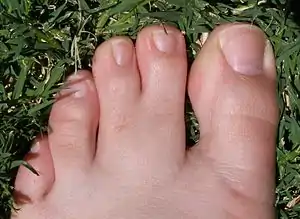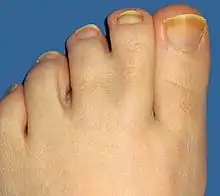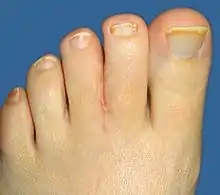Webbed toes
Webbed toes is the common name for syndactyly affecting the feet. It is characterised by the fusion of two or more digits of the feet. This is normal in many birds, such as ducks; amphibians, such as frogs; and mammals, such as kangaroos. In humans it is considered unusual, occurring in approximately one in 2,000 to 2,500 live births. Most commonly the second and third toes are webbed or joined by skin and flexible tissue. This can reach either part way up or nearly all the way up the toe.
| Webbed toes | |
|---|---|
 | |
| Human foot with partial simple syndactyly. | |
| Specialty | Medical genetics |
Cause
The exact cause of the condition is unknown. In some cases, close family members may share this condition. In other cases, no other related persons have this condition. The scientific name for the condition is syndactyly, although this term covers both webbed fingers and webbed toes. Syndactyly occurs when apoptosis or programmed cell death during gestation is absent or incomplete. Webbed toes occur most commonly in the following circumstances:
- Syndactyly or familial syndactyly
- Down syndrome
It is also associated with a number of rare conditions, notably:
- Aarskog–Scott syndrome
- Acrocallosal syndrome
- Apert syndrome
- Bardet–Biedl syndrome
- Carpenter syndrome
- Cornelia de Lange syndrome
- Edwards syndrome
- Jackson–Weiss syndrome
- Fetal hydantoin syndrome
- Miller syndrome
- Pfeiffer syndrome
- Smith–Lemli–Opitz syndrome
- Timothy syndrome
- Ectodermal dysplasia
- Klippel–Feil syndrome
Diagnosis
This condition is normally discovered at birth. If other symptoms are present, a specific syndrome may be indicated. Diagnosis of a specific syndrome is based on family history, medical history, and a physical exam. Webbed toes are also known as "twin toes," "duck toes," "turkey toes", "tree toes" and "tiger toes."
Severity can vary. Most cases involve the second and third toes but any number of toes can be involved. In some cases the toes are joined part way while in some the webbing can extend right up to the nails. In some cases the entire toes, including the nails and bones, can be fused.
Treatment


Webbed toes can be separated through surgery. Surgical separation of webbed toes is an example of body modification.
As with any form of surgery, there are risks of complications.
The end results depend on the extent of the webbing and underlying bone structure. There is usually some degree of scarring, and skin grafts may be required. In rare instances, nerve damage may lead to loss of feeling in the toes and a tingling sensation. There are also reports of partial web grow-back. The skin grafts needed to fill in the space between the toes can lead to additional scars in the places where the skin is removed.
Notable cases
- Dan Aykroyd – Canada, actor[1]
- Tricia Helfer – Canada, actress[2]
- Jacqui Hurley – Ireland, sports broadcaster[3]
- Ashton Kutcher – United States, actor[4]
- Thomas Robert Malthus, political
- Joseph Stalin – Soviet Union, General Secretary of the Communist Party of the Soviet Union[5]
- Danielle Panabaker – United States, actress[6]
See also
- Webbed foot
- Bird feet and legs - webbing and lobation
References
- Saner, Emine (2007-09-19). "Soul survivor". The Guardian. London. Retrieved 2008-01-01.
- "Tricia Trivia". Archived from the original on 2008-03-28. Retrieved 2008-03-22.
- Tubridy, Ryan (31 August 2011). "Here's what happened on today's show..." Tubridy. RTÉ 2fm. Archived from the original on 6 April 2012.
- "Star Tracks (People magazine)". Retrieved 2008-03-27.
- ""Among the Dead", MississippiReview.com". Archived from the original on 2008-03-18. Retrieved 2008-03-27.
- "famous people webbed toes".